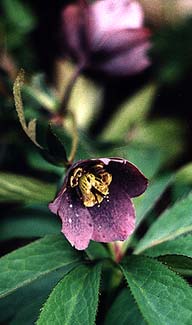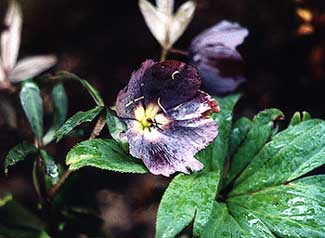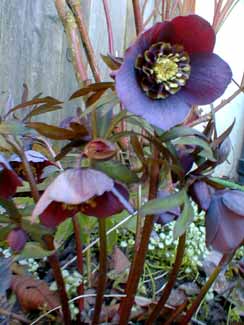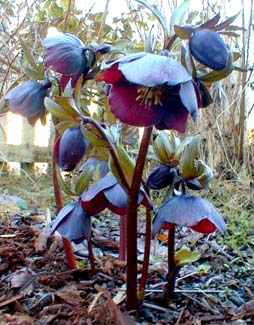 'Slaty,'
'Slaty,'
a Gothic Hellebore
"If rape & dagger, fire & hellebore,
Have not yet prinked out with designs ornate
The common canvas of our wretched fate,
It is, alas, that our faint soul demurs."
-Charles Baudelaire
(1821-1867)
(1821-1867)
This hybrid cultivar called 'Slaty' for its slate coloration was the first hellebore Granny Artemis & I ever purchased. About the same time we got a much younger Border Mix Hellebore to plant with the more mature one.
The young woman who sold these to us said hellebores needed to be put in the shade, & our generic garden books agreed, so we planted it near an oakleaf hydrangea where it got extremely little sun.
 We later learned her advice was abominable for our zone. The folks at Heronswood who specialize in hybrid hellebores said that here in the Northwest, hellebores do better in sunlight; & the plants we got from Heronswood, though planted later, grew much faster because they did have enough light.
We later learned her advice was abominable for our zone. The folks at Heronswood who specialize in hybrid hellebores said that here in the Northwest, hellebores do better in sunlight; & the plants we got from Heronswood, though planted later, grew much faster because they did have enough light.We left 'Slaty' in the shade for two years. It was interesting to compare first-hand the obvious preference for rather more sun than is commonly imagined, the sun-placed Rose Madder Hellebore vastly outpacing shade-situated 'Slaty.' These bloomed beautifully either way, but spread of the clump was very slow in the shade.
After two years in the deeper shade, 'Slaty' seemed too crowded by other plants that were overwhelming the area. So it seemed a good time to move 'Slaty' to a corner of a raised garden by the flagstone patio, not an extremely sunny spot but a good deal of light part of the year, when deciduous leaves have fallen & the early-flowering hellebores are active.
 Actually, 'Slaty' was first transplanted beside the back door where it was still overly protected & even worse, nearly invisible being slate-colored & in shadow, so we moved it to the raised bed that following autumn (2004). It has never complained in the least about the double-whammy transplants. The final location is particularly grand for it because hellebore flowers are so dangly, & more visible in a raised bed.
Actually, 'Slaty' was first transplanted beside the back door where it was still overly protected & even worse, nearly invisible being slate-colored & in shadow, so we moved it to the raised bed that following autumn (2004). It has never complained in the least about the double-whammy transplants. The final location is particularly grand for it because hellebore flowers are so dangly, & more visible in a raised bed.'Slaty's' previous companion "Border Mix" was left in the original shady location where it continues to grow rather slowly, yet it blooms exceedingly well even so, in fact it blooms earlier than any of the other hellebores, & there seems to be no reason to move that one to more sun.
The first two shots on this page were taken two different days in the second week of April 2002 (in its original location in shade). To overcome their shyness & get a really good shot of one of Slaty's blooms, I gently lifted the blossom up over a leaf. The third photo (2 March 2004) shows it in its second very temporary location. The fourth photo is from February 2005 in what is bound to remain its permanent location; by February it has plenty of flowers before new leaves have emerged.
 I've listened to some gardeners complain that hellebores disappoint because they lower their flowers on bent stems to face the ground. When purchased in full bloom from a garden shop they are often sitting up on tables so you can see face-on the most amazing showy colorful blooms. But when they're brought home & put in the ground, you will rarely see the insides of the blooms without bending down to lift up their shy faces.
I've listened to some gardeners complain that hellebores disappoint because they lower their flowers on bent stems to face the ground. When purchased in full bloom from a garden shop they are often sitting up on tables so you can see face-on the most amazing showy colorful blooms. But when they're brought home & put in the ground, you will rarely see the insides of the blooms without bending down to lift up their shy faces.A friend standing over a hellebore in our garden suggested making a fake water-feature out of a mirror underneath the hellebores so that the interior of the blossoms could be seen while looking down from above. This seemed a clever idea indeed, & some other gardener might be able to make that work, but it was not for me to try, as I wouldn't want to have to constantly be trying to keep dirt & leaves off the mirror. And for 'Slaty' at least, now that it is in a raised bed, its shyness is circumvented & it can be viewed from the side in its entirety, as in the fourth photo.
Personally I like things that are subtle in the landscape, but at the same time I love showy blooms too. Hellebores are one of the few flowers that has this balance of showiness & subtlety. And a flower that practically asks you to interact with it, to carefully lift a blossom to gaze into its heart, strikes me as pleasing.
Though the big leaves are evergreen through the winter, it is best to remove them at some point between January & March, so that their late-winter growth concentration will be in new leaves & blossoms. Buds & blossoms appear before new leaves, & the flowers are still vibrant when new leaves have reached their full size. In February, with old leaves clipped, this hellebore is just a mass of buds & blooms, but in mid-April it is a big-leafed clump & still producing numbers of blooms.